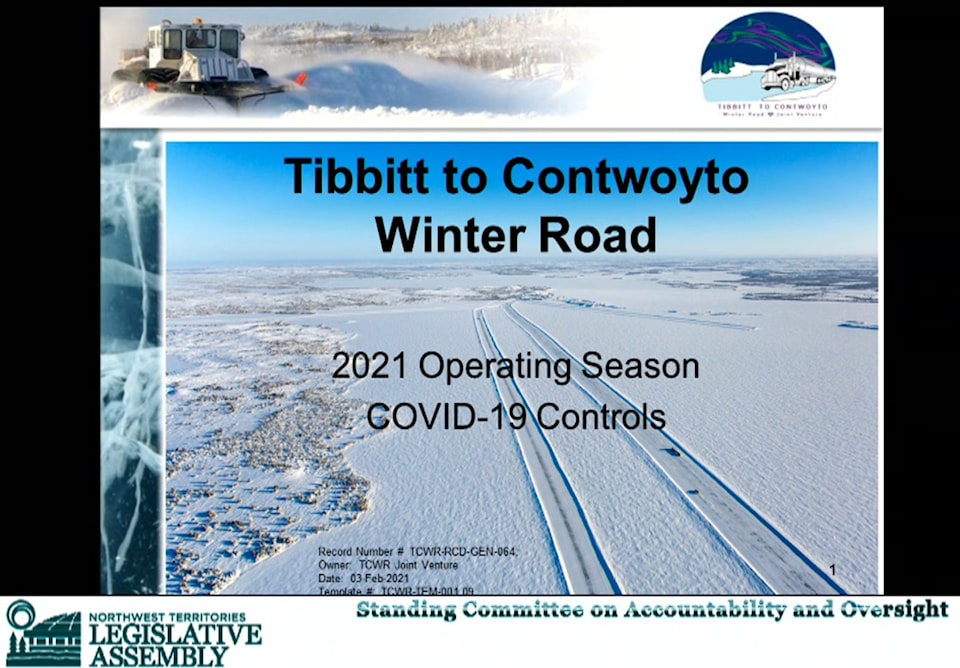The 600 or so drivers who will travel up the 400-kilometre road to the diamond mines this season are under a strict set of rules to prevent the spread of Covid-19.
Mike Lowing, spokesperson for the Tibbitt to Contwoyto Winter Road Joint Venture, addressed MLAs in a standing committee on accountability and oversight meeting on Monday.
He said an estimated 6,089 loads will be transported up the road this season, continuing a gradual decrease over the years since 8,766 loads were transported in 2016.
The winter road season for trucks opened on Monday facing two main challenges. The first is ice conditions that have been more difficult this year. The road in fact was closed two hours after opening on Monday due to a large storm in the Mackay Lake area, Lowing said.
But the largest challenge this year is the threat of Covid-19.
The Joint Venture’s exposure control plan is overseen by doctors Nick Withers and Michael Conrad, who regularly liaise with the NWT’s chief public health officer Dr. Kami Kandola.
Rio Tinto, De Beers and Canadian Arctic Diamond Company Ltd run the road together. Canadian Arctic was formerly known as Dominion Diamond Mines before the company purchased the Ekati Mine last week.
“We want to make sure the workforce going to the site is as clear as possible from transmitting the virus,” Conrad said.
Drivers screened
Most drivers, who are from outside the NWT undergo a screening process before they’re permitted to drive up the road to the three camps of Dome Lake, Lockhart Lake and Lac De Gras on the way to the mines. If they don’t pass, they can't continue.
Drivers have their temperatures checked and are taken to a separate station for polymerase chain reaction (PCR) tests for Covid-19. They’re tested the first and seventh days they work on the road and most will stay in a territorial bubble.
A small, select group does trans-border trips because they transport ammonium nitrate from Edmonton that can’t be stored in Yellowknife. That chemical is used as an explosive at mine sites. Each time those drivers cross the border they restart the Covid-19 test cycle.
Drivers who come up from the United States aren’t permitted to drive up the road, Lowing said.
If drivers show any signs of flu they’re separated, masked and checked, due to the fact that Covid-19 symptoms aren’t immediately distinguishable.
The winter road season has this year been shortened from eight weeks to seven to further reduce the time that non-NWT drivers spend in the territory.
“We’ve also changed our crew rotations to meet government requirements based on the two week rotations,” Lowing said.
Drivers checked in camps, too
In addition to testing the health of drivers, the Joint Venture is checking the drivers in camps on the road for compliance with Covid-19 safety regulations such as face masks and physical distancing.
“Those two controls are the strongest,” Lowing said. “We’ve seen a mixed bag of results. People in the camps are very social. At end of the day distancing tends to decrease. For example, we found facial barriers and distancing in our camps to be weak at best. We’re getting stricter. They must now wear mandatory surgical masks provided to them. Next week we’ll go back and re-monitor compliance.”
Drivers are tested before they begin their journey up the road. Currently the private sector testing provider can process 15 PCR tests in two and a half hours, though the Joint Venture aims to ramp up its test turnaround time to keep up with dispatching four trucks every 20 minutes.
After the roughly eight-hour drive to the Lockhart camp the results are available. If a driver’s test is positive they’re met by a team, who gives them a medical assessment to determine fitness.
The driver turns around and goes back to Yellowknife under escort. Once in Yellowknife the trucking carrier and Kandola discuss a management plan before the driver goes into quarantine.
Radar guns
Yellowknife North MLA Rylund Johnson asked Lowing about measures to mitigate traffic concerns on the Ingraham Trail, which connects to the start of the road.
Lowing said truck speeds are kept at 70 km/h. When driving down the Ingraham Trail an experienced “convoy leader” coaches new drivers to ensure they maintain 1,000 metres of separation to avoid causing inconvenience to people in the area.
“Blackout periods” when no trucks are dispatched on the road cover 7 to 8 a.m. and 5 to 6 p.m. seven days a week so residents and others on the trial have a break from the truck traffic.
The Joint Venture also operates two security services vehicles that essentially police the truckers using a radar gun to monitor for speeding, seatbelt use and unsafe or aggressive behaviour.
“We don’t fine drivers, we punish them. It sounds really draconian but if a driver doesn’t follow the rules they can have a one, three, five-day suspension, a season ban or a permanent ban depending on the severity of what they have.”
Drivers found to be not following Covid-19 regulations while in Yellowknife, such as before they head up the road, can be trackable and potentially reported to the Joint Venture, who could pass that information onto Protect NWT, Lowing explained.
Vehicles designated for winter road driving are identifiable by a territorial license plate on the driver’s window on the upper left or lower left corner.
“Once they have that ID plate then they’re trackable to us and you can pull in our health, safety and environment supervisor and we’ll begin an investigation if we believe there’s a Covid infraction,” he said.
